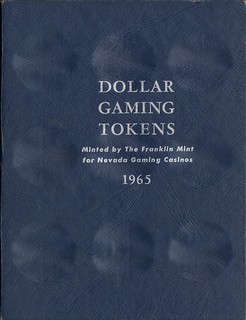
PREV ARTICLE
NEXT ARTICLE
FULL ISSUE
MORE ON JOSEPH SEGEL AND THE FRANKLIN MINTCoin Dealer Opinion on The Franklin Mint
Your excerpt from the Philadelphia Inquirer obit on native son Joseph Segel, creator of the Franklin Mint, was expectably complimentary. Collectors and dealers, on the other hand, might not speak so well of the dead. It is perhaps still an open question where the balance lies, between attracting new collectors with heavily promoted manufactured rarities, and driving them away when the aftermarket reveals their inherent worthlessness. Dealers in particular have no reason to love the Franklin Mint, which for decades diverted collector dollars away from legitimate numismatic items and other collectibles with actual historical value. I was pleased to find your link to a more balanced view with juicy details on FM's early and middle periods: David Alexander's lively article in CoinWeek, "The Rise and Fall of the Franklin Mint." Funnily enough, dealers today level the same criticisms at the U.S. Mint. Not without justification, of course - both Mints overpromote, overprice and oversell many of their products, leaving little upside for the original purchasers and mostly headaches for the aftermarket. Yet price aside, many of the products (not all, of course) are well-designed and well-made, and some may well end up as favorites of future collectors. Both mints create and supply talent - quite a few top sculptor-engravers have both the Franklin and U.S. Mints on their resume. And the numismatic community did gain at least one lasting benefit - funding that enabled the Token and Medal Society to publish Bob Julian's landmark book on the medals of the U.S. Mint. Segel likely made other donations to numismatic organizations that I'm not aware of. But as Scott noted, the Franklin Mint's primary legacy today is one of taking dollars out of the overall numismatic market. It will be interesting to see whether this view becomes more nuanced as more years pass. Do any of our readers actively collect or deal in Franklin Mint items? -Editor Franklin Mint's Initial Public Offering
David Thomason Alexander submitted these notes on the early days of the Franklin Mint and the listing of its stock. Thanks. -Editor I read with deep interest the laudatory obituary of the late Joe Segel. Whole books could be written on the meteoric rise and ultimate fall of General Numismatics Corp., (GNC) later known as the Franklin Mint and vigorous controversy would necessarily be a part of such a complete history. One factual correction is needed, however. GNC stock was first listed not on the New York Stock Exchange, but on the little known National Stock Exchange, then a distant number three in the roster of American securities exchanges. I know of this because my late brother, John L. Alexander (1938-1987) was instrumental in arranging the floating of the first stock through the securities firm of Hill, Darlington and Grimm, who were then very active in Promoting new stock issues. Segel's first major product was gaming tokens for casinos in Nevada and elsewhere who were seriously impacted by the disappearance of silver dollars from the banks. Base metal tokens to take their place brought Segel a total of $272,000 in the first year of reporting. John and I spent several days scrounging up examples of these tokens for Hill, Darlington and Grimm executives to examine. There was later a finely designed Franklin Mint token celebrating the new stock listing. Money realized from this first stock issue was used to assure Segel of a reasonably priced silver bullion supply just before the precious metals boom that was soon raging. The GNC name was soon retired and the Franklin Mint under later management was enveloped in controversy - remember Morley Safer and "Sixty Minutes..." The company was never a strictly numismatic phenomenon but a spectacular example of the success of American advertising and promotion. At the beginning many numismatic "names" were associated with the firm, none as closely as the late one-time ANA president Virginia Culver and numismatic writer-editor Russ Rulau. Virginia's name graced the catalogue of Franklin Mint material once published by Krause; Rulau never ceased to defend the Franklin Mint through his defense of Virginia... So much more could be written. Here is the listing for the GNC National Stock Exchange listing medal from the 1969 edition of Numismatic Issues of the Franklin Mint. -Editor 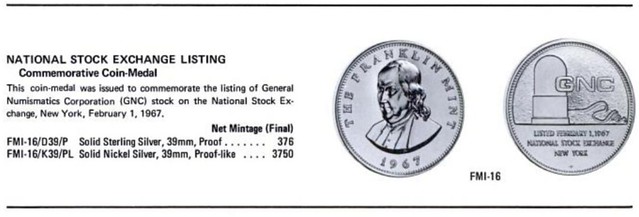 Franklin Mint Casino Tokens
David Lange submitted these notes on the Franklin Mint casino token albums. Thanks. -Editor
When casino customers began taking home their silver dollars instead of cashing them in before leaving, the coins soon disappeared from gambling tables and slot machines. Casino owners commissioned nickel-alloy tokens of dollar size to replace them. These served their purpose well, but they also became collectibles to some degree. In 1965 Segel contracted with a consortium of Nevada casinos to produce their tokens, and he also sought to market them directly to collectors. His folder for the 1965 tokens is shown in the attached photos. The following year he dropped Whitman in favor of Dansco, which produced two actual albums with clear slides for the 1966 series. I have these albums, too, but I haven't gotten around to taking images. This awaits completion of Volume Three in my series of books about album/folder publishers, which covers Whitman products. Volume Four will be a treatment of Dansco's various lines. 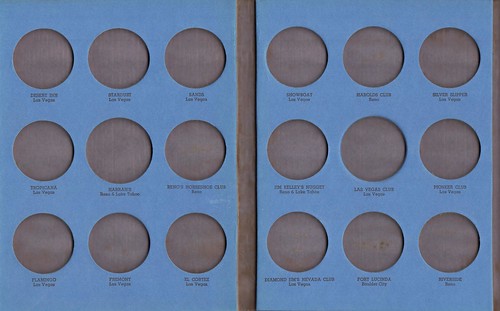 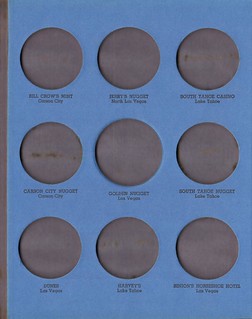 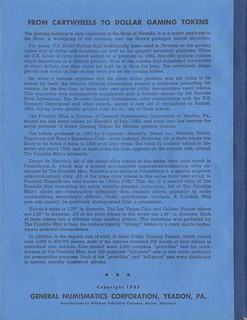 Dave adds: "I would not describe these metal tokens as "chips," which I associate with plastic or composite materials.The tokens are quite coinlike in most
respects, since they were substitutes for silver dollars. Six years later the gaming industry succeeded in having the U. S. Mint provide their tokens in the form of Eisenhower
Dollars."
Another interesting aspect of the casino tokens is their edge pattern of alternating plain and reeded segments, uniquely signifying each individual casino. The Franklin Mint was granted a patent for their system in 1967. See also the Wall Street Journal article (provided by David Sundman) and the CoinWeek article, which includes a note from retired U.S. Mint engraver Don Everhart, who previously worked for the Franklin Mint. Both are linked below. And elsewhere in this issue see excerpts from Lou Golino's excellent piece for Coin Update on the Franklin Mint's legacy for modern numismatics. -Editor To read the complete articles, see:
To read the earlier E-Sylum article, see:
THE BOOK BAZARREWayne Homren, Editor The Numismatic Bibliomania Society is a non-profit organization promoting numismatic literature. See our web site at coinbooks.org. To submit items for publication in The E-Sylum, write to the Editor at this address: whomren@gmail.com To subscribe go to: https://my.binhost.com/lists/listinfo/esylum All Rights Reserved. NBS Home Page Contact the NBS webmaster 
|
